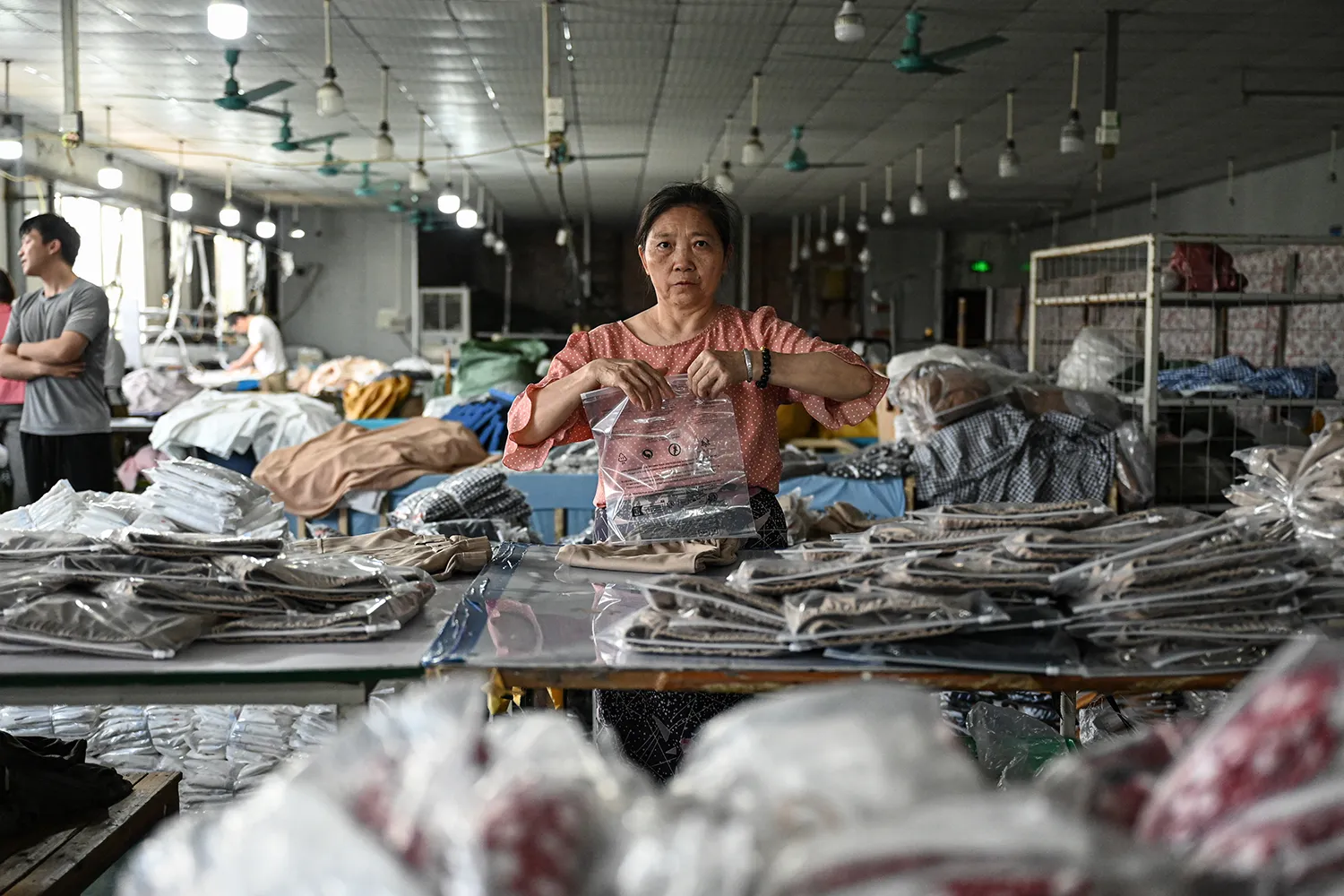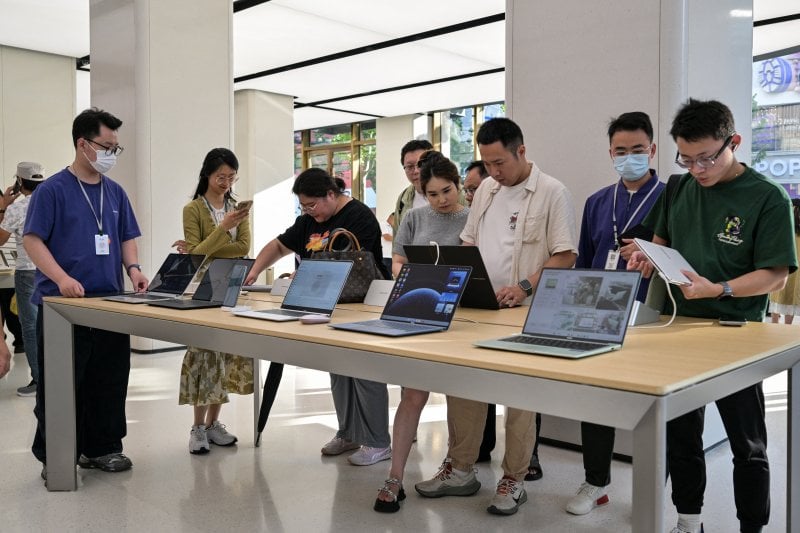Will Trump and the EU Kill Fast Fashion?

Analysis
Will Trump and the EU Kill Fast Fashion?
Circularity, not speed, may define the future of the industry.
An employee packages garments for the e-commerce company Temu at a clothing factory in Guangzhou, China, on April 16. Jade Go/AFP via Getty Images
The days of a T-shirt costing less than a cup of coffee may be numbered In a move that rattled global fashion supply chains and stock markets in April, the United States slapped sweeping tariffs on textile imports from key manufacturing hubs in Asia. Cambodia saw duties surge to 49 percent, Vietnam 46 percent, Bangladesh 37 percent, and India 27 percent. China was hit with a 145 percent tariff. Although the tariffs have been placed on a 90-day pause, the textile sector faces an additional regulatory blow.
As part of the new global tariff package unveiled on what he called “liberation day,” President Donald Trump signed an executive order ending the long-standing duty-free exemption for low-cost goods from China and Hong Kong. China is the world’s largest textile and garment manufacturer; in 2024, it exported approximately $18.39 billion worth of apparel to the United States, representing about 22 percent of total U.S. apparel imports. The so-called “de minimis” rule had allowed packages under $800 to enter the U.S. without taxes, tariffs, or significant inspection. While the executive order changing the rule has the supposed objective to stem the shipments of synthetic opioids from China to the United States, the exemption has been widely used by fast fashion giants like Shein and Temu to ship cheap e-commerce goods to the U.S. at minimal cost. Packages will now be subject to a tariff rate of 54 percent. As a result, U.S. consumers are likely to see significant price increases on clothing and footwear this year.
The days of a T-shirt costing less than a cup of coffee may be numbered In a move that rattled global fashion supply chains and stock markets in April, the United States slapped sweeping tariffs on textile imports from key manufacturing hubs in Asia. Cambodia saw duties surge to 49 percent, Vietnam 46 percent, Bangladesh 37 percent, and India 27 percent. China was hit with a 145 percent tariff. Although the tariffs have been placed on a 90-day pause, the textile sector faces an additional regulatory blow.
As part of the new global tariff package unveiled on what he called “liberation day,” President Donald Trump signed an executive order ending the long-standing duty-free exemption for low-cost goods from China and Hong Kong. China is the world’s largest textile and garment manufacturer; in 2024, it exported approximately $18.39 billion worth of apparel to the United States, representing about 22 percent of total U.S. apparel imports. The so-called “de minimis” rule had allowed packages under $800 to enter the U.S. without taxes, tariffs, or significant inspection. While the executive order changing the rule has the supposed objective to stem the shipments of synthetic opioids from China to the United States, the exemption has been widely used by fast fashion giants like Shein and Temu to ship cheap e-commerce goods to the U.S. at minimal cost. Packages will now be subject to a tariff rate of 54 percent. As a result, U.S. consumers are likely to see significant price increases on clothing and footwear this year.
Following the U.S. policy, the European Union this month proposed a €2 flat fee on each small package shipped directly to consumers, mainly targeting low-cost imports from Chinese retailers like Temu and Shein. The fee aims to offset the costs of customs checks and contribute to the EU budget, as over 90 percent of the 4.6 billion packages imported annually come from China.
Workers at their sewing stations in a garment factory in Savar, Bangladesh, on April 9.Munir Uz Zaman/AFP via Getty Images
Meanwhile, other textile and garment manufacturers across South Asia and Southeast Asia are grappling with the unpredictability of shifting tariff regimes, a volatile trade environment, and the question of what happens after Trump’s 90-day pause.. In Bangladesh, where ready-made garments account for over 80 percent of export earnings, the impact is especially severe. The U.S. has imposed a 37 percent reciprocal tariff, up from the previous 15 percent, on Bangladeshi imports, nearly all of which are garments and worth around $8.4 billion annually. If this steep tariff hike is enforced after the grace period, it could jeopardize the livelihoods of over 4 million workers, many of them women, in the country’s largest foreign exchange–earning sector.
These new trade measures are shaking an increasingly fragile system. Ripple effects of the tariffs are exposing deep vulnerabilities in the unsustainable fast fashion model that has dominated global apparel trade for over two decades. Fashion’s low-cost, high-speed engine depends on a seamless, linear supply chain: produce cheap garments in low-income countries; sell and ship them to the West; Western consumers dispose of them after a few wears. Could this disruption be a chance to reimagine and build a more sustainable global textile trade system?
A worker sorts incoming clothing items at a sorting center in Stockholm on April 10.Jonathan Nackstrand/AFP via Getty Images
It’s not just the tariffs that threaten the current model. A less abrupt but potentially more transformative environmental policy shift is coming from the European Union, which is sharpening its environmental agenda with a particular eye on textiles. While the EU’s Ecodesign for Sustainable Products Regulation (adopted in July 2024) does not impose tariffs, it introduces textile-specific rules, including minimum recycled content, durability standards, and requirements for repairability. These requirements could become non-tariff trade barriers for textile exporters, but are not ideological so much as born of necessity.
The global textile industry consumes an estimated 3.25 billion tons of materials annually, with over 99 percent derived from virgin resources, and in addition is responsible for large amounts of water consumption and chemical pollution. Of the vast waste generated, only around 1 percent is currently recycled.
The accumulation of textile waste, much of it from fast fashion that is poorly designed with very short lifecycles, is rapidly emerging as a global environmental crisis. It is not only creating massive uncontrolled waste dumps but also contributing to chemical, microplastic, and greenhouse gas emissions harmful to human health and the environment. The average American throws away over 81.5 pounds of clothing every year, which is an estimated 11 million tons of textile waste. Europeans generated an estimated total of 6.95 million tons of textile waste in 2020—around 35 pounds per person. This textile waste often consists of synthetic materials, which contribute significantly to landfill volumes and take decades or even centuries to decompose.
The California Senate Bill 707—also called the Responsible Textile Recovery Act of 2024—is the first legislation in the United States aimed at holding fashion brands and retailers accountable for the lifecycle of their products. Under this new law—which passed in September 2024—companies are required to implement collection and recycling programs for textiles to prevent them from ending up in landfills. Several countries in the EU, such as France and the Netherlands, have also launched extended producer responsibility (EPR) programs, requiring producers and importers to responsibly manage the end-of-life for fashion products.
These national policies are an important measure, yet the problem goes deeper. Driven by the global fast fashion industry, the growing volumes of textile waste produced combined with increased waste management requirements and landfill costs make disposal in consumer markets costly. As a result, over the past two decades, there have been rapidly growing exports of discarded clothes to secondary markets. Traded textile waste from the United States and Europe, but also China, has become a growing concern of international dimensions. Vast uncontrolled textile dump sites are growing rapidly in multiple countries, including in Chile’s Atacama Desert, Ghana, Kenya, and Pakistan, and are symptoms of wider, systemic problem of the global fashion industry.
A woman sifts among used clothes amid tons discarded in the Atacama Desert in Chile on Sept. 26, 2021.Martin Bernetti/AFP via Getty Images
About 92 million tonnes of textile waste is produced globally and traded volumes of disposed clothing increased sevenfold over the past decades, growing at a rate of 10 percent per year. The European Union, China, and the United States were the leading exporters, with 30 percent, 16 percent, and 15 percent respectively. And policies as they are currently designed could exacerbate this trade.
With these shipments, it is often challenging to differentiate between textile waste, clothing that can be reused or resold, and garments suitable for recycling, as they frequently appear similar but require distinct sorting processes for proper disposal or repurposing. Further, the trade in used textiles, whether they are secondhand clothes or straight-out waste, transfers the burden of waste management to these secondary markets—many of which lack capacity to properly manage the waste—resulting in significant environmental and human harm.
Shipments of textile waste or unsold low-quality garments to developing countries are often falsely declared as secondhand clothing. Unlike secondhand textiles that hold resale value in local markets, textile waste carries a negative value. The issue of illicit textile waste trade has emerged as a growing concern for the UN Commission on Trade and Development, which is now trying to address it through dedicated policy dialogue. Criminal networks often mix the contents and profits from illegal textile waste trafficking with those earned through the legitimate secondhand textile trade, making it harder to detect. This practice makes illicit textile waste trafficking a highly profitable yet low-risk crime, as enforcement is weak, investigations and prosecutions are infrequent, and penalties for violators tend to be minimal. Criminal networks take advantage of weak oversight, inadequate border enforcement, corrupt officials and regulatory loopholes, and recipient countries lack the infrastructure to handle the influx of low-quality textiles.
Up to 40 percent of Europe’s used textile exports to African countries are waste, according to the European Environment Agency. These problems are complicated by broader issues of illicit or poorly regulated global trade in waste. Between 15 and 30 percent of waste shipments are estimated to be illegal.
According to a report by the Financial Action Task Force (an independent inter-governmental body that develops and promotes policies against money laundering and terrorist financing), the profit generated from illicit waste—not only textiles but also electronic waste and other waste streams—amounts to $10 to 12 billion annually, which puts profits on a par with other major crime areas such as arms trafficking (between $1.7 billion and $3.5 billion in 2020) or illicit trade of protected species ($1.8 billion for animal species and $9.3 billion for plant species).
#gallery-2 {
margin: auto;
}
#gallery-2 .gallery-item {
float: left;
margin-top: 10px;
text-align: center;
width: 100%;
}
#gallery-2 img {
border: 2px solid #cfcfcf;
}
#gallery-2 .gallery-caption {
margin-left: 0;
}
/* see gallery_shortcode() in wp-includes/media.php */
- A worker sorts garments at a Temu clothing factory in Guangzhou on April 16.
- Garment packages are piled up at a textile factory that supplies clothes to Shein in Guangzhou on June 11, 2024. Jade Gao photos/AFP via Getty Images
Addressing these complex challenges will require stricter controls and regulations in both the countries shipping and receiving textile waste. However, current experience shows that, implemented in isolation, domestic policy actions can actually drive illicit trading activities, as these policies can incentivize operators to ship waste out of a country rather than pay official landfill fees. If recipient countries try to introduce unilateral measures to prevent the import of such waste, then the waste flows get diverted elsewhere. This highlights the urgent need for more coordinated global policy action to better regulate the global trade of used and waste textile shipments.
The EU is trying to close the net on waste exports through the new EU waste shipment regulation that entered into force in May 2024. The regulation will ban textile waste shipments to non-OECD countries (unless an exemption is requested). The issue is complicated by trading partners importing the EU’s waste pushing back against the legislation. Traders in used textiles have argued that the stricter rules will limit exports of high-quality textiles, hurting local businesses that resell the clothes on second-hand markets. In Kenya, about 2 million people are employed in this trade. Policies will need to balance supporting the legal second-hand clothing trade—which provides affordable clothing and economic opportunities in developing countries—while cracking down on illegal dumping practices.
Enforcement agencies must pay significantly more attention to ensure policies achieve their intended impact. This is possible: In the United States, prior to the tariffs, the Department of Homeland Security in April 2024 increased the scrutiny on textile imports due to concerns over forced labor in Xinjiang’s apparel sector. The new strategy introduced strengthened enforcement efforts through intensified targeting of small package shipments, joint trade special operations, and increased customs audits and foreign verifications. The same effort and scrutiny will be needed to crack down on illegal textile waste exports, while at the same time enabling traceability of legally shipped textile items.
More systemic policy solutions are needed to go beyond waste trade and address the root causes. For example, textile EPRs that coordinate across jurisdictions and set waste prevention targets as well as measures to reduce the overall volume of new clothes put on the market. Together with eco-design requirements, these policies can help to ensure fashion is designed to be free of toxic chemicals, and has longer use phases and multiple cycles of reuse.
A circular textile economy, in essence, is a question of economics and trade. The linear fashion model has run up against its ecological and geoeconomic limits. As trade routes reconfigure and tariffs and regulatory pressure mounts, companies that once raced to be the fastest may now compete on resilience and circular design. Even if Trump and the EU’s trade measures haven’t killed fast fashion—and it’s far from dead—they have certainly slowed it down, and woven it into a far more tangled and complex policy landscape.
This post is part of FP’s ongoing coverage of the Trump administration. Follow along here.
Patrick Schröder is a senior research fellow at the Environment and Society Centre, Chatham House.
Stories Readers Liked
In Case You Missed It
A selection of paywall-free articles

Four Explanatory Models for Trump’s Chaos
It’s clear that the second Trump administration is aiming for change—not inertia—in U.S. foreign policy.




























Join the Conversation
Commenting is a benefit of a Foreign Policy subscription.
Subscribe
Subscribe
Already a subscriber?
.
View Comments
Join the Conversation
Join the conversation on this and other recent Foreign Policy articles when you subscribe now.
Subscribe
Subscribe
Not your account?
View Comments
Join the Conversation
Please follow our comment guidelines, stay on topic, and be civil, courteous, and respectful of others’ beliefs.
View Comments
Change your username |
Log out
Change your username:
CANCEL
Confirm your username to get started.
The default username below has been generated using the first name and last initial on your FP subscriber account. Usernames may be updated at any time and must not contain inappropriate or offensive language.